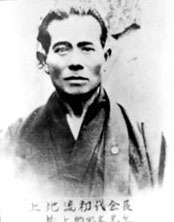|
KANBUN UECHI
 Kanbun Uechi, born
in 1877, grew up in the proud, traditional Okinawan family of
bushi (Samurai or Shizoku) lineage. Kanbun Uechi, born
in 1877, grew up in the proud, traditional Okinawan family of
bushi (Samurai or Shizoku) lineage.
Like many would-be martial arts students in the last days of the
19th century, Kanbun Uechi's first years of study were as much
about patience as about martial arts! The first three years of
Kanbun's training were devoted only to the kata Sanchin. During
the first two years, training focused on strengthening the
student's body through hard work as well as martial arts practice.
In the spring of 1904, the same year that war began between Japan
and Russia, Kanbun Uechi received the Menkyo Kaiden certificate
naming him a master of Chinese Pangainoon (half hard-half soft
style). It was a monumental event in his twenty-seven years of
life. He had vowed to himself to become proficient in the martial
arts of China or never return to his homeland.
In January 1948, Kanbun Uechi became ill with nephritis that he
fought for eleven months. Kanbun, 71 years old, died on Ie-jema
Island on November 25, 1948. The Shinjo family were the only ones
present when Kanbun died.
Kanbun Uechi has been described by many people who knew him as a
kind, gentle, quiet man in day-to-day life but a fierce, intense,
and strict instructor of Pangainoon ryu. His life was as unique
and eventful as other forefathers of karate, as was his influence.
KANEI UECHI
 In 1927, at sixteen
years old, Kanei traveled to Wakayama and joined his father (Kanbun
Uechi's.) Kanei joined the Shataku dojo and began chuan fa
training under his father. In 1927, at sixteen
years old, Kanei traveled to Wakayama and joined his father (Kanbun
Uechi's.) Kanei joined the Shataku dojo and began chuan fa
training under his father.
Uechi ryu karate and the Futenma dojo were open to the public,
including American servicemen in 1958.
|